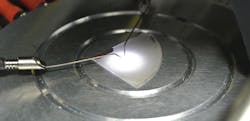White-light-emitting LEDs, used widely for lighting due to their high lumens per watt efficiency and long lifetimes, take one of two forms. The predominant form consists of an indium gallium nitride (InGaN)-based blue LED combined with a yellow YAG phosphor excited by the blue light; the yellow and blue combined create white light. Sometimes, to improve the white-light quality, a small amount of red-emitting praseodymium phosphor is added. The other form, which produces low-quality white light but can be controlled to produce a variety of colors, contains red, green, and blue LEDs and no phosphor. Now, researchers at the King Abdullah University of Science and Technology (KAUST; Thuwal, Saudi Arabia) have invented a third type of white LED, which is monolithic, requires no phosphor, and can be color-tuned to emit warm, natural, or cool white.
Fabricated via metalorganic vapor-phase epitaxy, the InGaN-based device contains both blue-light emitting quantum wells with a 20% indium content and 34% indium red quantum wells with a 34% indium content; to create broadband emission, the researchers created V-shaped pits in the structure below the quantum wells (which also had the effect of improving current injection). Combined, the monolithic LED emits light across the entire visible spectrum. Controlling the current passing through the device changes the emission from warm white through to cool white. The color-rendering index (CRI) of the white LEDs reaches a quite good value of 88 at an injection current of 10 mA, which produces a warm white, and falls off somewhat at other whiteness types, reaching 78 at a color temperature of 6110 K (cool white).
“The next step is to improve the emission efficacy of the red emission component. The red emission is a key factor of the high color-rendering LEDs with the natural white emission,” says Daisuke Iida, one of the researchers. Reference: D. Iida et al., Appl Phys. Lett., 117, 172103 (2020); https://doi.org/10.1063/5.0026017.
About the Author
John Wallace
Senior Technical Editor (1998-2022)
John Wallace was with Laser Focus World for nearly 25 years, retiring in late June 2022. He obtained a bachelor's degree in mechanical engineering and physics at Rutgers University and a master's in optical engineering at the University of Rochester. Before becoming an editor, John worked as an engineer at RCA, Exxon, Eastman Kodak, and GCA Corporation.

